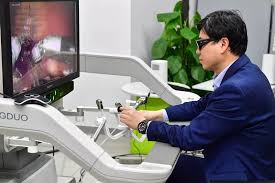In a world where medical resources are not distributed equally, telemedicine offers a promising solution. Telemedicine allows doctors to provide medical care remotely, using technology to bridge the gap between patients and healthcare providers.
Recently, Professor Zhang Xu achieved something remarkable in the field of telemedicine. He led a remote surgery from Rome to Beijing, a distance of 8,000 kilometers. During a conference in Italy, he used a surgical console to control robotic arms and perform the delicate task of removing a lesion from a patient’s prostate.
This surgery was a significant milestone in medical technology. It showed that even over long distances, remote surgeries could be performed with great precision. The delay, or latency, was just 135 milliseconds, much lower than the 200-millisecond standard for telesurgery. This means that the surgery was almost as smooth and accurate as if Professor Zhang had been in the same room as the patient.
Professor Zhang highlighted the success of the procedure, stating, “During today’s surgery, there was almost no delay, and it was almost the same as an on-site surgery.” His words underscore the potential of telemedicine to provide high-quality medical care across great distances.
This groundbreaking achievement demonstrates the power of telemedicine to connect experts with patients who might otherwise lack access to specialized care. As technology continues to advance, telemedicine could play a crucial role in making healthcare more accessible and equitable worldwide.


